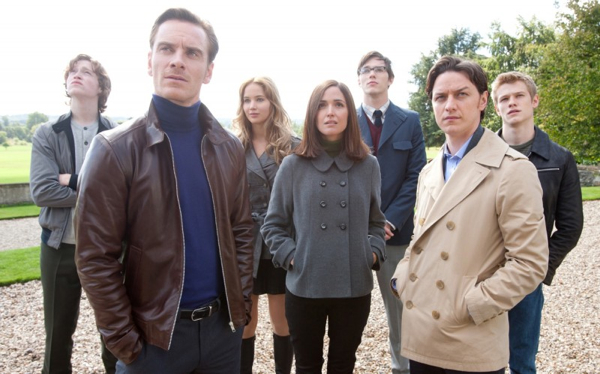Movie review by Greg Carlson
A calculated effort to rejuvenate and rethink a once hot franchise for Marvel, 20th Century Fox, and their partners, “X-Men: First Class” embraces the Silver Age origins of Stan Lee and Jack Kirby’s misunderstood mutants via its smoothly designed period setting. Rewinding the clock to JFK’s 1962 Camelot nightmare, a revisionist Cuban Missile Crisis places the emergent superheroes at the heart of historical destiny. In addition to the throwback threads and cheeky slang, director Matthew Vaughn efficiently communicates a number of origin yarns with a verve that puts Kenneth Branagh’s leaden, wooden, barren “Thor” to shame.
In a tableau that has gained the status of a collective memory among comic readers, the 1944 concentration camp odyssey of Erik Lehnsherr is shared again, this time embellished with the welcome appearance of perfectly sinister Nazi doctor Kevin Bacon, whose very namesake – along with a resume of wonderfully over the top performances – suggests a level of ham that helps constitute an equilibrium with some of the movie’s straighter, more humorless character renderings. Despite drooling web chatter to the contrary, it is Bacon who makes January Jones look good and not the other way around. Pureeing all kinds of X-Men history, Bacon is a dandy Sebastian Shaw, even if he doesn’t have a ponytail or, as Bacon himself describes it, dress like Benjamin Franklin.
While Lehnsherr suffers unspeakable horrors in Europe, young Charles Xavier is raised in wealth and privilege in the Westchester County, New York mansion that will later house his school for “gifted youngsters.” Like Bryan Singer, who returns to the series with co-story and producing credits, Vaughn grasps the inherently dynamic contrasts between the future Magneto and Professor X and sets to work mortaring the foundation of Xavier’s MLK-like advocacy for non-violence and Magneto’s Malcolm X-esque embrace of mutant self-empowerment and resistance “by any means necessary.” James McAvoy’s pre-paralysis telepath gets stuck with the usual pedantic speeches urging tolerance and responsibility, while Michael Fassbender lights up Magneto’s more fiery and charismatic calls for insurrection.
Caught between the two men is the young Raven/Mystique, the blue-skinned shape-shifter played by Rebecca Romijn in the first set of “X” movies. Embodied here by an appealing Jennifer Lawrence, Mystique dials up another of the comic’s central themes: the pain of the outsider accompanied by an almost desperate desire to fit in and be “normal,” no matter the cost. On the page, the teen angst of the X-Men has occasionally ventured into the psychologically complex territory of sexual desire. In this movie, Mystique’s unrequited feelings for Charles define one of the most striking of the film’s soap opera subplots. Later, a table-turning seduction allows Magneto to encourage Mystique to let her freak flag fly, and the scene features one of two cameo appearances (the other a seconds-long meeting in which a perfectly placed F-bomb detonates to much applause) engineered for fanboys and fangirls.
X-Geeks grumble about re-writes to comic canon, but the cinematic variation on the formation of the original team’s line-up strongly suggests that some of the other founding figures will join the Beast in the second and third installments of a planned trilogy. Movie continuity in the X-Men universe hews to its own logic, however, and given the out-of-chronology introductions of Angel and Iceman in the previous films, the constitution of the team in upcoming episodes is anyone’s guess. Several of the mutants inevitably fade into the background, turning up principally to do battle in action sequences. Old-schoolers might enjoy the realization of Banshee (Caleb Landry Jones), an X-Man adversary who joined the team in the successful Giant-Size X-Men #1 in 1975. The rest can enjoy the finely tuned emotional melodrama that defines the fantastic world of genetically uncanny men and women.
